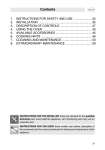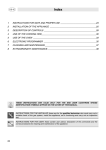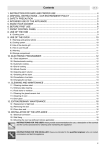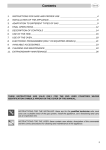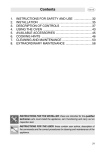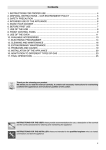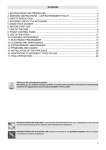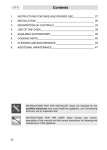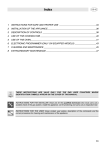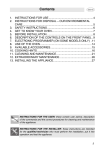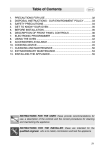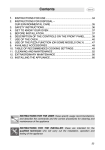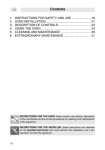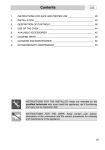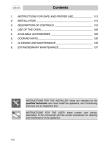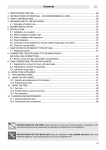Download Smeg SC081MFX Product manual
Transcript
Contents 1. 2. 3. 4. 5. 6. 7. 8. 9. 10. 11. 12. 13. 14. INSTRUCTIONS FOR USE..................................................................................4 INSTRUCTIONS FOR DISPOSAL – OUR ENVIRONMENTAL CARE ................5 SAFETY INSTRUCTIONS....................................................................................6 GET TO KNOW YOUR OVEN..............................................................................7 BEFORE INSTALLATION ....................................................................................7 DESCRIPTION OF THE CONTROLS ON THE FRONT PANEL .........................8 ELECTRONIC ANALOGUE CLOCK (ON SOME MODELS ONLY) ..................10 ELECTRONIC PROGRAMMER (ON SOME MODELS ONLY) .........................14 USE OF THE OVEN ...........................................................................................17 AVAILABLE ACCESSORIES .............................................................................18 COOKING HINTS ...............................................................................................19 CLEANING AND MAINTENANCE......................................................................24 EXTRAORDINARY MAINTENANCE..................................................................29 INSTALLING THE APPLIANCE .........................................................................30 INSTRUCTIONS FOR THE USER: these specify usage recommendations, and describe the commands and the correct cleaning and maintenance operations for the appliance. INSTRUCTIONS FOR THE INSTALLER: these are intended for the qualified technician who will carry out the installation, operation and testing of the appliance. 3 Instructions for use 1. INSTRUCTIONS FOR USE THIS MANUAL IS AN INTEGRAL PART OF THE APPLIANCE. IT MUST BE KEPT IN ITS ENTIRETY AND IN AN ACCESSIBLE PLACE FOR THE WHOLE WORKING LIFE OF THE OVEN. WE ADVISE CAREFUL READING OF THIS MANUAL AND ALL THE INSTRUCTIONS THEREIN BEFORE USING THE APPLIANCE. INSTALLATION MUST BE CARRIED OUT BY QUALIFIED PERSONNEL IN ACCORDANCE WITH THE REGULATIONS IN FORCE. THIS APPLIANCE IS INTENDED FOR DOMESTIC USES AND CONFORMS TO THE EEC DIRECTIVES CURRENTLY IN FORCE. THE APPLIANCE HAS BEEN BUILT TO CARRY OUT THE FOLLOWING FUNCTIONS: COOKING AND REHEATING OF FOOD; ALL OTHER USES ARE CONSIDERED IMPROPER. THE MANUFACTURER DECLINES ALL RESPONSIBILITY FOR IMPROPER USE. DO NOT USE THIS APPLIANCE FOR HEATING ROOMS. DO NOT DISCARD PACKING IN THE HOME ENVIRONMENT. SEPARATE THE VARIOUS WASTE MATERIALS AND TAKE THEM TO THE NEAREST SPECIAL GARBAGE COLLECTION CENTRE. THIS APPLIANCE IS MARKED ACCORDING TO THE EUROPEAN DIRECTIVE 2002/96/EC ON WASTE ELECTRICAL AND ELECTRONIC EQUIPMENT – (WEEE). THIS GUIDELINE IS THE FRAME OF A EUROPEAN-WIDE VALIDITY OF RETURN AND RECYCLING ON WASTE ELECTRICAL AND ELECTRONIC EQUIPMENT. DO NOT OBSTRUCT VENTILATION OPENINGS AND HEAT DISPERSAL SLITS. THE I.D. PLATE WITH TECHNICAL DATA, SERIAL NUMBER AND BRAND NAME IS POSITIONED VISIBLY ON THE OVEN DOOR FRAME. THE PLATE MUST NOT BE REMOVED. DO NOT USE METALLIC SPONGES OR SHARP SCRAPERS: THEY WILL DAMAGE THE SURFACE. USE NORMAL NON-ABRASIVE PRODUCTS AND A WOODEN OR PLASTIC TOOL IF NECESSARY. RINSE THOROUGHLY AND DRY WITH A SOFT CLOTH OR DEERSKIN. DO NOT ALLOW RESIDUES OF SUGARY FOODS (SUCH AS JAM) TO SET INSIDE THE OVEN. IF LEFT TO SET FOR TOO LONG, THEY MIGHT DAMAGE THE ENAMEL LINING OF THE OVEN. 4 Safety instructions 2. INSTRUCTIONS FOR DISPOSAL ENVIRONMENTAL CARE – OUR Our product's packing is made of non-polluting materials, therefore compatible with the environment and recyclable. Please help by disposing of the packing correctly. Find the addresses of collection, recycling and disposal centres from your retailer or from the competent local organisations. Do not throw the packing or any part of it away. They can constitute a suffocation hazard for children, especially the plastic bags. Your old appliance also needs to be disposed of correctly. Important: hand over your appliance to the local agency authorised for the collection of electrical appliances no longer in use. Correct disposal means intelligent recycling of valuable materials. Before disposing of your old appliance remove the door and leave the racks in their normal working positions so that children cannot get stuck in the oven compartment whilst playing. It is also necessary to cut the electric power cord and remove it along with the plug. INFORMATION FOR USERS Pursuant to Directives 2002/95/EC, 2002/96/EC and 2003/108/EC relating to the reduction of the use of hazardous substances in electrical and electronic appliances, as well as to the disposal of refuse. The crossed out bin symbol on the appliance indicates that the product, at the end of its useful life, must be collected separately from other refuse. Therefore, the user must consign the product that has reached the end of its working life to the appropriate differentiated collection centres for electrical and electronic refuse, or deliver it back to the retailer when purchasing an equivalent product, on a one for one basis. Adequate differentiated collection for the subsequent forwarding of the decommissioned product to recycling, treatment and ecologically compatible disposal contributes to avoiding possible negative effects on the environment and on health and promotes the recycling of the materials of which the appliance consists. The illicit disposal of the product by the user results in the application of administrative sanctions. 5 Instructions for the user 3. SAFETY INSTRUCTIONS CONSULT THE INSTALLATION INSTRUCTIONS FOR THE SAFETY STANDARDS FOR ELECTRICAL OR GAS APPLIANCES AND FOR THE VENTILATION FUNCTIONS. IN YOUR INTERESTS AND FOR YOUR SAFETY IT HAS BEEN ESTABLISHED BY LAW THAT THE INSTALLATION AND SERVICING OF ALL ELECTRICAL APPLIANCES IS TO BE CARRIED OUT BY QUALIFIED PERSONNEL IN ACCORDANCE WITH THE REGULATIONS IN FORCE. OUR REGULAR INSTALLERS GUARANTEE A SATISFACTORY JOB. GAS OR ELECTRICAL APPLIANCES MUST ALWAYS BE DISCONNECTED BY QUALIFIED PEOPLE. THE PLUG TO BE CONNECTED TO THE POWER CORD AND ITS SOCKET MUST BE OF THE SAME TYPE AND CONFORM TO THE REGULATIONS IN FORCE. THE SOCKET MUST BE ACCESSIBLE AFTER THE APPLIANCE IS BUILT IN. NEVER UNPLUG BY PULLING ON THE CABLE. IT IS OBLIGATORY FOR ALL ELECTRICAL SYSTEMS TO BE GROUNDED ACCORDING TO THE METHODS REQUIRED BY SAFETY RULES. IMMEDIATELY AFTER INSTALLATION CARRY OUT A BRIEF INSPECTION TEST, FOLLOWING THE INSTRUCTIONS BELOW. SHOULD THE APPLIANCE NOT FUNCTION, DISCONNECT IT FROM THE POWER SUPPLY AND CALL THE NEAREST TECHNICAL ASSISTANCE CENTRE. NEVER ATTEMPT TO REPAIR THE APPLIANCE. NEVER PUT INFLAMMABLE OBJECTS IN THE OVEN: THEY COULD BE ACCIDENTALLY LIGHTED AND CAUSE FIRES. DURING USE THE APPLIANCE BECOMES VERY HOT. TAKE CARE NOT TO TOUCH THE HEATING ELEMENTS INSIDE THE OVEN. THE USE OF THIS APPLIANCE IS NOT PERMITTED TO PEOPLE (INCLUDING CHILDREN) OF REDUCED PHYSICAL AND MENTAL ABILITY, OR LACKING IN EXPERIENCE IN THE USE OF ELECTRICAL APPLIANCES, UNLESS THEY ARE SUPERVISED OR INSTRUCTED BY ADULTS OR PEOPLE RESPONSIBLE FOR THEIR SAFETY. BEFORE THE APPLIANCE IS PUT INTO OPERATION, ALL LABELS AND PROTECTIVE FILMS APPLIED INSIDE OR OUTSIDE MUST BE REMOVED. ALWAYS CHECK THAT THE CONTROL KNOBS ARE IN THE 0 (OFF) POSITION WHEN YOU FINISH USING THE OVEN. The manufacturer declines all responsibility for damage to persons or things caused by the non-observance of the above prescriptions or by interference with any part of the appliance or by the use of non-original spares. 6 Instructions for the user 4. GET TO KNOW YOUR OVEN CONTROL PANEL OVEN LIGHT OVEN FAN (ONLY ON SOME MODELS) PANS AND RACKS RUNNERS 5. BEFORE INSTALLATION Do not discard packing in the home environment. Separate the various waste materials and take them to the nearest special garbage collection centre. In order to remove all manufacturing residues, it is recommended to clean the inside of the appliance. For further information on cleaning see point "12. CLEANING AND MAINTENANCE". Before using the oven and the grill for the first time, pre-heat to maximum temperature long enough to burn any manufacturing oily residues which could give the food a bad taste. After an electricity supply failure, for instructions for setting the time, see points "7. Electronic Analogue Clock (on some models only)" and "8. Electronic programmer (on some models only)". 7 Instructions for the user 6. DESCRIPTION OF THE CONTROLS ON THE FRONT PANEL All the oven controls are grouped together on the front panel. The symbols used are described in the table below. RETRACTABLE KNOBS In order to use the control knobs they have to be extracted from their housing: just press them and they will pop out in the ON position. During operation they could go back in their housing; just push them fully in until they stop. THERMOSTAT KNOB Cooking temperature is selected by turning the knob clockwise to the desired setting, between 50° and 250°C. THERMOSTAT LIGHT The light comes on to indicate that the oven is heating up. When it goes out, the preset heating temperature has been reached. When the light flashes regularly it means that the temperature inside the oven is kept steady on the set level. 8 Instructions for the user FUNCTIONS SWITCH KNOB Turn the knob in either direction to select a function from the following: NO FUNCTION SET UPPER + LOWER HEATING ELEMENTS + VENTILATION THAWING GRILL ELEMENT + VENTILATION UPPER + LOWER HEATING ELEMENTS FAN-ASSISTED HEATING ELEMENT GRILL ELEMENT LOWER HEATING ELEMENT + VENTILATION LOWER HEATING ELEMENT UPPER + LOWER HEATING ELEMENTS + FAN-ASSISTED HEATING ELEMENT HOB CONTROL KNOB Allows to adjust the heating of the hob by turning the knob clockwise to the desired setting, between 2 and 12. DUAL HEATING HOB CONTROL KNOB Allows to adjust the heating of the hob in dual heating zones. Turning the knob clockwise between 2 and 12 heats only the smaller diameter area. Turning the or symbol and knob to the releasing it (it returns to 12) heats both the larger and smaller diameter areas. To regulate the heating level, turn the knob anti-clockwise to the desired setting. To return to heat the smaller diameter area only, turn the knob to 0 and then to between 2 and 12. 9 Instructions for the user 7. ELECTRONIC ANALOGUE CLOCK (ON SOME MODELS ONLY) LIST OF FUNCTIONS TIMER BUTTON END OF COOKING BUTTON CLOCK ADJUSTMENT AND RESET VALUE DECREASE BUTTON VALUE INCREASE BUTTON 7.0.1 "DEMO" Function Models with analogue/digital programmer feature a "DEMO" function which deactivates the heating elements while leaving the other functions unchanged. To activate it, simply press the , and keys for 5/6 seconds. A confirmation beep will inform the user that the function is active. To deactivate it, simply repeat the same procedure. 10 Instructions for the user 7.0.2 Setting the time When the oven is used for the first time, or after an electricity supply failure, the display flashes at regular intervals. Press for 1 / 2 seconds to stop the display flashing and start the procedure for setting the correct time. Press the value modification keys or to increase or decrease the setting by one minute for each pressure. Press one of the two value modification keys until the current time appears. 6/7 seconds after the last key is pressed, the clock will start from the time set. At the end of each programmed operation 8 beeps will sound 3/4 times at intervals of about 1 and a half minutes. This sequence can be stopped at any time by pressing any key. 7.0.3 Timer This function does not stop cooking; it simply activates the buzzer. • Press and the display will light up as shown in figure 1; • Within 6/7 seconds, press the or keys to set the timer. Each time a key is pressed, 1 outside segment, representing 1 minute of cooking time, will light up or go out. (figure 2 shows a cooking time of 10 minutes). 6/7 seconds after the last key is pressed, the countdown will start; when it finishes, the buzzer will sound. During the countdown, the current time can be • • • 1) 2) viewed by pressing the key once; press it again to return to the timer display. At the end of the countdown, the oven must be switched off manually by turning the thermostat and functions switch knob to 0. 11 Instructions for the user 7.0.4 Programming Cooking duration: the 2nd button can be pressed to set the cooking duration. Before it can be set, the thermostat must be turned to the desired cooking temperature and the functions switch knob to any setting. To set the cooking duration, proceed as follows: • Press the key for 1 / 2 seconds; the pointer will locate on 12 (Fig. 1). • Use the • each pressure on the key adds 1 minute to the cooking duration, and every 12 minutes a new inside segment will light up (figure 2 shows a cooking duration of 1 hour). Once the desired duration is obtained, cooking will and key to set the cooking duration: 1) start about 6 seconds after the last pressure on • • • or . 2) Once cooking has started the display will show the current time, represented by the constantly illuminated segments, and the minutes left to the end of the cooking time, represented by the flashing segments (each flashing segment means 12 minutes of cooking time left). At the end of the cooking time the timer will switch the oven heating elements off, the beeps will start to sound and the numbers on the dial will flash. The duration can also be reset by resetting the program selected: pressing the central key for 1 or 2 seconds will delete the duration set and the oven will have to be manually switched off. Warning: it is not possible to set cooking durations of more than 6 hours. 12 Instructions for the user Cooking start: besides setting the cooking duration it is also possible to set the cooking start time (with a maximum delay of 12 hours in relation to the current time). To set the cooking start/end time, proceed as follows: • Set the cooking duration as described in the previous point. • Within 6/7 seconds of the last pressure on the or keys, press the key again to set the cooking start time. The current time will appear on the display with internal segments illuminated to show the end of • • cooking time. Use the and keys to set the cooking start time. 6/7 seconds after the last key is pressed, the display will show the current time and the cooking start and end times, which will be represented by the illuminated inside segments. The display segments will be constantly illuminated as long as the current time is not the same as the cooking start time; as soon as the current time reaches the set starting time, all the inside segments will start to flash, indicating that the oven has started cooking. At the end of the cooking time the timer will switch the oven heating elements off, the beeps will start to sound and the numbers on the dial will flash. • To reset the whole program set, keep the central key pressed for 1 or 2 seconds: if cooking has already started, the oven will have to be switched off manually. • Here we can see a programming example: the current time is 7:06 and cooking is programmed to start at 8.00 and end at 9.00. • At 8 o'clock the inside segments between 8 and 9 will start to flash, while the hours hand will remain still. Warning: for the oven to start cooking operations after the programming procedures just described, the thermostat and functions switch knob must be correctly set on the desired temperature and function. 13 Instructions for the user 8. ELECTRONIC PROGRAMMER MODELS ONLY) (ON SOME LIST OF FUNCTIONS TIMER BUTTON COOKING DURATION BUTTON END OF COOKING BUTTON VALUE DECREASE BUTTON VALUE INCREASE BUTTON MANUAL MODE BUTTON 8.1 Setting the time When the oven is used for the first time, or after an electricity supply failure, the display flashes at regular intervals, showing . Press to stop the display flashing. Press the value modification keys or within 5 seconds to increase or decrease the setting by one minute for each pressure. Press one of the two value modification keys until the current time appears. Before each programmer setting, activate the desired function and temperature. 14 Instructions for the user 8.2 Semiautomatic cooking This function only switches the oven off automatically at the end of the cooking time. Press the key and the display will light up showing the figures ; keep it pressed, and at the same time use the value modification keys or to set the cooking duration. A few seconds after the key is released, the count of the programmed cooking duration will start and the display will show the current time together with the symbols A and . 8.3 Automatic cooking This function switches the oven on and off in fully automatic mode. Press the key and the display will light up showing the figures ; keep it pressed, and at the same time use the value modification keys or to set the cooking duration. Press the key and the display will show the sum of the current time plus the cooking duration just set: keep it pressed, and at the same time use the value modification keys or to adjust the cooking end time. A few seconds after the key is released, the programmed count will start and the display will show the current time together with the symbol A. When the cooking start time calculated automatically by the programmer on the basis of the data entered is reached, the display will show both the A and symbols. After the setting, to view the cooking time left press the key; to view the cooking end time press the key. The logic prevents the setting of incompatible values (e.g. the programmer will not accept a cooking end time with a duration which is too long for this value). 8.4 Timer The programmer can also be used as an ordinary timer. Press the key and the display will show the figures ; keep it pressed and simultaneously press the value modification keys or . When the key is released the programmed count will start and the display will show the current time and the symbol . 15 Instructions for the user After the setting, to display the time left press the key. In timer mode, the system will not cut out operation of the oven at the end of the set time. 8.5 End of cooking At the end of the cooking time the oven will switch off automatically and simultaneously a buzzer will start to sound in on-off mode. After the buzzer is stopped, the display will return to show the current time together with the symbol, indicating that the oven is again ready for use in manual mode. 8.6 Adjusting the buzzer volume The buzzer volume can be varied (3 settings) while it is operating by pressing the key . 8.7 Stopping the buzzer The buzzer stops automatically after seven minutes. It can be stopped manually by pressing the and keys together. To switch off the oven, return all the knobs to the 0 setting in sequence. 8.8 Deleting the data set With the program set, keep the key of the function to be deleted ( or ) pressed, while at the same time the value is obtained by pressing the value modification keys or . The programmer will interpret deletion of the duration as the end of cooking. 8.9 Modifying the data set The cooking data set can be modified at any moment by keeping the key of the function to be modified ( or ) pressed and at the same time pressing the value modification keys 16 or . Instructions for the user 9. USE OF THE OVEN Before using the oven, check that the display is showing the symbol (see point "8.1 Setting the time"). 9.1 Warnings and general advice Before using the oven and the grill for the first time, pre-heat to maximum temperature long enough to burn any manufacturing oily residues which could give the food a bad taste. During cooking, do not cover the bottom of the oven with aluminium or tin foil and do not place pans or oven plates on it as this may damage the enamel coating. If you wish to use greaseproof paper, position it so that it does not interfere with the hot air circulation inside the oven. To prevent any steam in the oven creating problems, open the door in two stages: half open (5 cm approx.) for 4-5 seconds and then fully open. To access food, always leave the door open as short a time as possible to prevent the temperature in the oven from falling and ruining the food. When the door is opened oven ventilation is automatically switched off; it then resumes as soon as the door is closed. 9.2 Cooling system The oven is equipped with a cooling system which automatically comes on when the oven is being turned on. The fan causes a steady outflow of air from above the door which may continue for a brief period of time even after the oven has been turned off. 9.3 Inside light The oven light comes on: When the oven door is opened, or by turning the functions knob to any symbol. 17 Instructions for the user 10. AVAILABLE ACCESSORIES The oven features 4 runners for positioning pans and racks at different heights. Rack: useful for holding cooking containers. Pan rack: for placing on top of a tray for cooking foods which may drip. Oven pan: useful for collecting fat from foods placed on the rack above. Pastry plate: for baking cakes, pizza and oven desserts. Roof liner: remove it to simplify cleaning inside the oven. Chromium-plated gripper: removing hot racks and pans. useful for The oven accessories intended to come into contact with food are made of materials that comply with the provisions of Directive 89/109/EEC, dated 21/12/88 and of Decree Law 108, dated 25/01/92. Not all accessories are provided on some models. Accessories available on request Original accessories may be ordered from any Authorised Service Centre. 18 Instructions for the user 11. COOKING HINTS In fan-assisted mode preheating should be carried out at 30/40°C above the cooking temperature. This considerably shortens cooking times and reduces power consumption, as well as giving better cooking results. Keep the oven door closed during cooking. 11.1 Traditional cooking FUNCTIONS SWITCH THERMOSTAT 50 ÷ 250 °C This traditional cooking method, in which heat comes from above and below, is suitable for cooking food on a single level. You have to pre-heat the oven until the set temperature is reached. Place the food in the oven only after the thermostat indicator light has turned off. Put frozen meat in immediately, without waiting for it to thaw. The only precaution you need to take is to set the temperature about 20°C lower and cooking time about 1/ 4 longer than you would for fresh meat. 11.2 Hot-air cooking FUNCTIONS SWITCH THERMOSTAT 50 ÷ 250 °C This system is suitable for cooking on several levels, including different types of food (fish, meat etc.), without tastes and smells mingling. Air circulation in the oven ensures a uniform heating. Multiple cooking is possible as long as the cooking temperature of the different foods is the same. 19 Instructions for the user 11.3 Delicate cooking FUNCTIONS SWITCH THERMOSTAT 50 ÷ 250 °C This type of cooking, for which it is extremely important to preheat the oven in fan-assisted mode, is particularly suitable for finishing cooking of foods on the base or for cooking procedures that require heating especially in the lower part. The pan should be placed on the bottom runner. 11.4 Grill cooking FUNCTIONS SWITCH THERMOSTAT O Permits rapid browning of foods. For short-term cooking of small quantities, place the rack in the fourth runner from the bottom. For longterm cooking and grills, put the rack in the lowest runner in accordance with the size of the pieces. Keep the oven door closed during cooking. Grilling with the door open can permanently damage the oven and jeopardise safety whilst the grill is on. 11.5 Hot-air grilling FUNCTIONS SWITCH THERMOSTAT 200 °C Ensures uniform heating with greater heat penetration into the food. Food will be lightly browned on the outside and remain soft inside. Keep the oven door closed during cooking. Heating up time must not exceed 60 minutes. 20 Instructions for the user Keep the oven door closed during cooking. Grilling with the door open can permanently damage the oven and jeopardise safety whilst the grill is on. 11.6 Thawing FUNCTIONS SWITCH THERMOSTAT 0 The movement of air ensured by the fan causes faster thawing of foods. The air circulating inside the oven is at room temperature. Thawing at room temperature has the advantage of not altering the taste and appearance of the food. 21 Instructions for the user 11.7 Table of recommended cooking settings Cooking times, especially for meat, vary according to the thickness, quality of the food and to consumer's taste. Cooking times are given for a preheated oven. TRADITIONAL COOKING RUNNER POSITION FROM BOTTOM TEMPERATURE °C TIME IN MINUTES 2-3 2-3 210 - 230 210 - 230 30 40 2 2 2 2 2 2 2 2 170 - 200 210 - 240 170 - 200 170 - 200 170 - 200 140 - 170 170 - 200 170 - 200 30 - 40 / KG. 30 - 40 / KG. 30 - 40 / KG. 45 - 60 45 - 60 45 - 60 50 - 60 40 - 50 FISH 1-2 170 - 200 According to dimensions PIZZA 1-2 210 - 240 40 - 45 DESSERTS SHORT PASTRY DOUGHNUT CROISSANTS FRUIT CAKE PARADISE CAKE APPLE PIE RICE PUDDING 1-2 1-2 1-2 1-2 1-2 1-2 1-2 170 - 200 165 170 - 200 170 - 200 170 190 180 15 - 20 35 - 45 40 - 45 20 - 30 60 60 60 FIRST COURSES LASAGNE OVEN-BAKED PASTA MEAT ROAST VEAL ROAST BEEF ROAST PORK CHICKEN DUCK GOOSE-TURKEY RABBIT LEG OF LAMB GRILL COOKING RUNNER POSITION FROM BOTTOM PORK CHOPS FILLET OF PORK FILLET OF BEEF LIVER VEAL ESCALOPES HALF CHICKEN SAUSAGES MEAT-BALLS FISH FILLETS TOAST 22 4 3 3 4 4 3 4 4 4 4 TIME IN MINUTES st 1 SURFACE 2nd SURFACE 7-9 9 - 11 9 - 11 2-3 7-9 9 - 14 7-9 7-9 5-6 2-4 5-7 5-9 9 - 11 2-3 5-7 9 - 11 5-6 5-6 3-4 2-3 Instructions for the user HOT-AIR COOKING RUNNER POSITION FROM BOTTOM TEMPERATURE °C TIME IN MINUTES 2 2 2 190 - 210 190 - 210 190 - 210 20 - 25 25 - 30 20 - 25 2 2 2 2 2 2 2 2 2 2 2 150 - 170 150 - 160 160 - 170 160 - 180 130 - 150 170 - 180 170 160 - 170 150 - 160 150 - 160 160 - 170 140 - 170 65 - 90 70 - 100 65 - 90 35 - 45 100 - 130 40 - 45 70 - 90 100 - 160 160 - 240 80 - 100 30 - 50 15 - 25 FISH 2-3 150 - 170 According to dimensions PIZZA BREAD TOAST 2-3 2-3 1-2 210 - 240 190 - 210 220 - 240 30 - 50 40 7 DESSERTS (PASTRY) DOUGHNUT FRUIT CAKE CROISSANTS SHORT PASTRY RICE PUDDING APPLE PIE PARADISE CAKE 2-3 2-3 2-3 2-3 2-3 2-3 2-3 150 - 160 150 - 160 150 - 160 150 - 160 150 - 160 150 - 160 150 - 160 35 - 45 40 - 50 40 - 60 25 65 65 65 FIRST COURSES LASAGNE OVEN-BAKED PASTA CREOLE RICE MEAT ROAST VEAL ROAST PORK ROAST BEEF FILLET OF BEEF ROAST LAMB ROAST-BEEF ROAST CHICKEN ROAST DUCK ROAST TURKEY ROAST RABBIT ROAST HARE ROAST PIGEON 23 Instructions for the user 12. CLEANING AND MAINTENANCE Before performing any operations requiring access to powered parts, switch off the power supply to the appliance. Do not use a steam jet for cleaning the inside of the oven. 12.1 Cleaning stainless steel To keep stainless steel in good condition it should be cleaned regularly after use. Let it cool first. 12.2 Ordinary daily cleaning To clean and preserve the stainless steel surfaces, always use only specific products that do not contain abrasives or chlorine-based acids. How to use: pour the product on a damp cloth and wipe the surface, rinse thoroughly and dry with a soft cloth or deerskin. 12.3 Food stains or residues Do not use metallic sponges or sharp scrapers: they will damage the surface. Use normal non-abrasive products and a wooden or plastic tool if necessary. Rinse thoroughly and dry with a soft cloth or deerskin. Do not allow residues of sugary foods (such as jam) to set inside the oven. If left to set for too long, they might damage the enamel lining of the oven. 24 Instructions for the user 12.4 Cleaning the oven For best oven upkeep clean regularly after having allowed to cool. Take out all removable parts. • • Clean the oven racks with hot water and non-abrasive detergent. Rinse and dry. For easier cleaning, the door can be removed (see point “12.6 Removing the door”) 12.5 Cleaning the oven with self-cleaning panels (on some models only) The oven is equipped with panels made of continuous self-cleaning enamel. These panels make the oven easier to clean and ensure that it remains efficient over time. 12.5.1 Use of self-cleaning panels To keep the inside of the oven clean and free from food residues and unpleasant smells, it should periodically be operated empty at a temperature of at least 200° C for a time varying between 30 and 60 minutes. This allows the self-cleaning panels to oxidise any deposits present, which can then be wiped away with a damp sponge once the oven has cooled. 12.5.2 Maintenance of self-cleaning panels The panels should not be cleaned using abrasive creams and ordinary cleaners. Simply wipe with a damp sponge to avoid damaging the special enamel coating of the panels. 25 Instructions for the user 12.5.3 Removing the self-cleaning panels Remove all accessories from inside the oven and proceed as follows: 1 Remove the side grids (fig.1); 2 Slide out the side panels “F” and “G” (fig. 2); 3 Extract the rear panel “A” after first unscrewing the threaded ring “C” (fig. 2); 4 Reassemble the panels by returning them to their original conditions. 1) 2) 12.6 Removing the door 12.6.1 Removing the door with mobile hinges With the door completely open, lift the levers A until they touch the hinges B and take hold of the two sides of the door with both hands close to the hinges. Raise the door to an angle of about 45° and remove it. If the hinges have not locked, repeat the operation, raising the levers A and keeping the door slightly raised. To reassemble, fit the hinges B into their grooves, then lower the door into place, ensuring that it remains fitted into the grooves C, and lower the levers A. 26 Instructions for the user 12.6.2 Removing the door with pins Open the door completely and insert the pins (supplied) into the holes from the inside. Close the door to an angle of about 45° and lift it off. To reassemble, fit the hinges into their grooves, then lower the door into place and extract the pins. 12.7 Removing the glass panels The glass in the door should always be kept thoroughly clean. For easier cleaning, the door glazing can be fully removed by proceeding as described below. After opening the door and locking it in place as described in point “12.6 Removing the door”, remove the internal glass panel levering it as illustrated in figure 1, and detach the 4 pins that fix the glass to the door. If your oven also has a middle glass panel (figure 2) this can be extracted simply by lifting it upwards. After having carried out the cleaning, first of all replace the middle glass panel (if your oven has one), and then position the internal glass hinging it, as shown in figure 3, on the grooves of the oven door (see part A in figure 3). When the glazing has been positioned on the door, exert a slight pressure on the four fixing pins. If the door should close during these operations, simply relock one of the hinges as described in point “12.6 Removing the door”. The glass panels can now be washed separately. 27 Instructions for the user Use absorbent kitchen roll; in case of stubborn dirt remove with a damp sponge and an ordinary detergent. Warning: before removing the glass panels, make sure that the door has been locked in an open position as described in points "12.6 Removing the door". This operation might also have to be repeated during the glass removal process if the door is accidentally freed. To reassemble the door glazing, follow the provided instructions in reverse order. WARNING. Do not use the appliance without the glass panels mounted: the outside surface of the door will overheat 28 Instructions for the user 13. EXTRAORDINARY MAINTENANCE The oven may require extraordinary maintenance or replacement of parts subject to wear such as seals, bulbs, and so on. The following instructions describe how to carry out these minor maintenance operations. Before any intervention that requires access to live parts, disconnect the power supply of the appliance. 13.1 Changing the light bulb Remove the bulb protector A by turning anticlockwise and change bulb B with a similar one (25 W). Re-fit the bulb protector A. Use only oven bulbs (T 300°C). 13.2 Removing the door seal To permit thorough cleaning of the oven, the seal may be removed. Before removing the seal, take off the door as described above. Once the door has been taken off, lift the tabs at the corners as shown in the figure. 29 Instructions for the installer 14. INSTALLING THE APPLIANCE 14.1 Electrical connection The I.D. plate with technical data, serial number and brand name is positioned visibly on the oven door frame. The plate must not be removed. The appliance must be electrically grounded in compliance with the electrical system safety regulations. If a fixed connection is being used it is necessary to fit the power line with an omnipolar circuit breaker with a contact opening gap equal to or greater than 3 mm, in an easily accessible position close to the appliance. If a plug and socket connection are being used make sure that the plug and socket are compatible. Avoid use of adapters and shunts as these could cause overheating and risk of burns. 14.1.1 Ovens with hob controls On ovens with hob controls the power supply cable is not supplied. Use a H05RR-F or H05RN-F rubber cable and when positioning it ensure that it does not touch the metal parts of the appliance's external casing. To access the terminal board, remove the appliance's back cover by unscrewing the relative screws. If necessary, change the positions of the jumpers on the terminal board as shown, then connect the wires, making sure that the earth wire is at least 20 mm longer. Fix the power supply cable to the appliance using the cable clamp provided. 30 Instructions for the installer Operation at 220-240 V~: use a H05RR-F / H05RN-F three-core cable (cable of 3 x 4 mm2). Operation at 380-415V 2N~: use a H05RR-F / H05RN-F four-core cable (4 x 2.5 mm2). Operation at 380-415V3N~: use a H05RR-F / H05RN-F five-core cable (5 x 2.5 mm2). The end to be connected to the appliance must be an earth wire (yellowgreen) at least 20 mm longer. WARNING: The values indicated above refer to the cross-section of the internal conductor. 14.2 Positioning the oven The oven is designed for mounting into any piece of furniture as long as it is heat-resistant. Proceed according to the dimensions shown in Figures 1, 2 and 3. For installing under a work top, follow the dimensions given in Figure 1-3. For installing under a work top with combined cooking hobs, ensure a minimum clearance from any side walls of at least 110 mm as shown in Figure 1. When installing in tall units, comply with the dimensions shown in figure 1-2, bearing in mind that the top/rear of the unit must have an opening 80-90 mm deep. Tighten the 4 screws A inside the frame (fig. 1). For installing beneath a countertop hob, allow for a rear and bottom clearance as shown in Figure 1 (ref. B). See the relevant instructions for fitting and securing the hob. 31 Instructions for the installer Never use the oven door to lever the oven into place when fitting. Avoid exerting too much pressure on the oven door when open. 32 Instructions for the installer 14.3 Hob-oven connection Once installed, the combined hob must be connected to the oven. Fit the oven into the built-in installation opening, leaving enough room to carry out the operations described below: connect the yellow-green earth wire of the hob to the oven's earth terminal A (see figure); connect the hob connectors to the sockets provided on the top casing of the oven. The colours and symbols of the connectors must correspond to those on the oven sockets; if the hob has a residual heat warning device connector, connect it to the unused socket on the right-hand side. At this point the oven can be completely built-in into the cabinet, taking care to place the power supply cable along the best possible route and ensuring that it is not touching hot parts. 33































